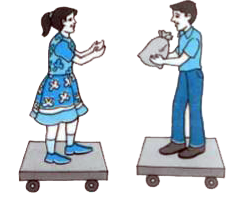Two objects of masses 100 and 200 g are moving along the same line and direction with velocities 2 ms−1 and 1ms−1 respectively. They collide and after collision, the first object moves at a velocity of 1.67 ms−1. Determine the velocity of the second object.Solution in Gujrati
m1=100kg=0.1 kg:m2=200g=0.2 kg,
u1=2ms−1,u2=1ms−1v1=1.67ms−1v2=?
According to the law of conservation of momentum.
m1u1+m2u2=m1v1+m2v2
∴0.1×2+0.2×1=0.1×1.67+0.2×v2
∴ 0.2+0.2=0.167+0.2 v2
∴ 0.4-0.167=0.2 v2
∴0.2v2=2.33∴v2=0.2330.2=1.165ms−1
Topper's Solved these Questions
- FORCE AND LAWS OF MOTIONBOOK - KUMAR PRAKASHANCHAPTER - FORCE AND LAWS OF MOTIONEXERCISE - QUESTIONS AND ANSWERS( Answer the following questions in very short :)
20 Videos
- FORCE AND LAWS OF MOTIONBOOK - KUMAR PRAKASHANCHAPTER - FORCE AND LAWS OF MOTIONEXERCISE - QUESTIONS AND ANSWERS( Choose the correct option from those given below each question :)
34 Videos
- FORCE AND LAWS OF MOTIONBOOK - KUMAR PRAKASHANCHAPTER - FORCE AND LAWS OF MOTIONEXERCISE - Activity 9.4
1 Videos
- GRAVITATIONBOOK - KUMAR PRAKASHANCHAPTER - GRAVITATIONEXERCISE - ACTIVITY 10.4
2 Videos
Similar Questions
Define : Force
View SolutionNewton's II law of motion connects:
View SolutionAsk two children to stand on two separate carts as shown in the figure

Give one o them a bag full of sand.Ask them to play a game of catch with the bag
Does each of them receive an instantaneous reaction as a result of the sand bag(action)?
View SolutionTake an empty plastic bottle . Close the mouth of the bottle with an airtight stopper . Put it in a bucket filled with watere . The bottle floats .
Push the bottle into the water. You feel an upward push. Try to push it further down. You will find it difficult to push deeper and deeper. Water exerts a force on the bottle in upward direction. Now release the bottle. It bounces back to the surface.
Does the force due to the gravitational attraction of the earth act on this bottle? If so, why doesn't the bottle stay immersed in water after it is released ?
View SolutionTwo objects of masses 100g and 200g are moving along the same line in the same line in the same direction with velocities of 2m/s and 1m/s, respectively. They collide and after the collison, the first object moves at a velocity of 1.67m/s in the same direction. Determine the velocity of the second object.
View Solution100 किग्रा तथा 200 ग्राम की दो वस्तुएँ एक ही दिशा तथा लाइन में क्रमशः 2 मीटर/सेकण्ड तथा 1 मीटर/सेकण्ड के वेग से गतिमान है | ये टकराती है तथा टकराने के पश्चात् दूसरी वस्तु का वेग 1.67 मी/से हो तो पहली वस्तु का वेग ज्ञात कीजिए |
View Solution100g और 200g द्रव्यमान की दो वस्तुएँ एक ही रेखा के अनुदिश एक ही दिशा में 2ms−1और1ms−1 के वेग से गति कर रही हैं | दोनों वस्तुएँ टकरा जाती हैं | टक्कर के पश्चात् प्रथम वस्तु का वेग 1.67ms−1 ही जाता है तो दूसरी वस्तु का वेग ज्ञात करें |
View Solution100 ग्राम और 200 ग्राम द्रव्यमान की दो वस्तुएँ एक ही रेखा के अनुदिश एक ही दिशा में क्रमश: 2 मी से−1 और 1 मी से−1 के वेग से गति कर रही है। दोनों वस्तुएँ टकरा जाती है। टक्कर के पश्चात प्रथम वस्तु का वेग मी 1.67 से−1 हो जाता है, तो दूसरी वस्तु का वेग ज्ञात करे।
View SolutionTwo objects of masses 100 g and 200 g are moving along the same line and direction with velocities of 2 ms^(-1) and 1 ms^(-1) respectively. They collide and after collection the first object moves at veloctiy 1.67 ms^(-1) determine the velocity of the second object.
View SolutionTwo objects of masses 100 g and 200 g are moving along the same line and direction with velocities of 2 m/s and 1 m/s, respectively. They collide and after the collision , the first object moves at a velocity of 1.67 m /s Determine the velocity of the second object.
View SolutionTwo objects of masses 100 g and 200 g are moving along the same line and direction with velocities of 2 m s-1 and m s-1 respectively. They collide and after the collision, the first object moves at a velocity of 1.67 ms-1. Determine the velocity of second object.
View SolutionTwo objects of masses 100g and 200g are moving along the same line in the same direction with velocities of 2m//s and 1m//s , respectively. They collide and after the collison, the first object moves at a velocity of 1.67 m//s in the same direction. Determine the velocity of the second object.
View SolutionTwo objects of masses 100 g and 200 g are moving along the same line and direction with velocities of 2ms−1 and 1ms−1 respectively. They collide and after the collision, the first object moves with a velocity of 1.67ms−1Determine the velocity of the second object.
View SolutionTwo objects of masses 100 g and 200 g are moving along the same line and direction with velocities of 2 m/s and 1 m/s, respectively. They collide and after the collision, the first object moves at a velocity of 1.67 m/s. Determine the velocity of the second object.
View SolutionTwo objects of mass 1 kg and 0.5 kg are moving on linear path with velocity 4 ms−1 and 2 ms−1 in the same direction respectively collide with each other. After collision, velocity of first object is 3ms−1 in the same direction. Find out the velocity of the second object.
View Solution
